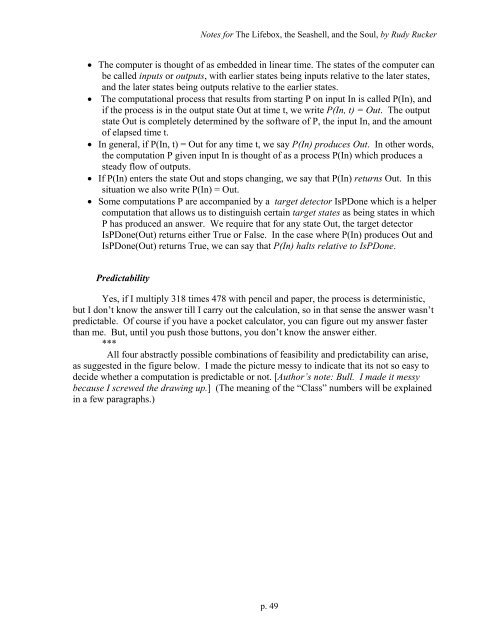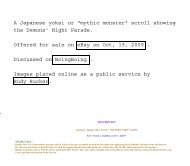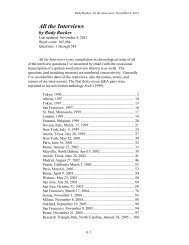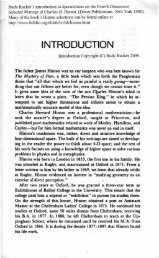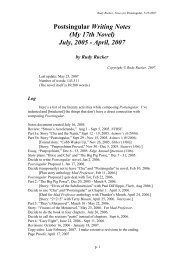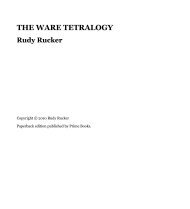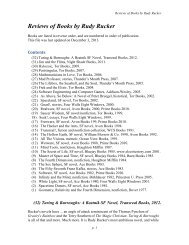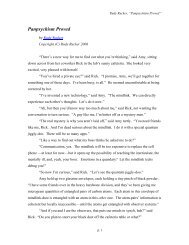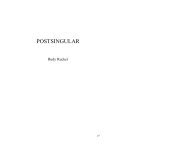Notes for the Lifebox, the Seashell, and the Soul - Rudy Rucker
Notes for the Lifebox, the Seashell, and the Soul - Rudy Rucker
Notes for the Lifebox, the Seashell, and the Soul - Rudy Rucker
Create successful ePaper yourself
Turn your PDF publications into a flip-book with our unique Google optimized e-Paper software.
<strong>Notes</strong> <strong>for</strong> The <strong>Lifebox</strong>, <strong>the</strong> <strong>Seashell</strong>, <strong>and</strong> <strong>the</strong> <strong>Soul</strong>, by <strong>Rudy</strong> <strong>Rucker</strong><br />
• The computer is thought of as embedded in linear time. The states of <strong>the</strong> computer can<br />
be called inputs or outputs, with earlier states being inputs relative to <strong>the</strong> later states,<br />
<strong>and</strong> <strong>the</strong> later states being outputs relative to <strong>the</strong> earlier states.<br />
• The computational process that results from starting P on input In is called P(In), <strong>and</strong><br />
if <strong>the</strong> process is in <strong>the</strong> output state Out at time t, we write P(In, t) = Out. The output<br />
state Out is completely determined by <strong>the</strong> software of P, <strong>the</strong> input In, <strong>and</strong> <strong>the</strong> amount<br />
of elapsed time t.<br />
• In general, if P(In, t) = Out <strong>for</strong> any time t, we say P(In) produces Out. In o<strong>the</strong>r words,<br />
<strong>the</strong> computation P given input In is thought of as a process P(In) which produces a<br />
steady flow of outputs.<br />
• If P(In) enters <strong>the</strong> state Out <strong>and</strong> stops changing, we say that P(In) returns Out. In this<br />
situation we also write P(In) = Out.<br />
• Some computations P are accompanied by a target detector IsPDone which is a helper<br />
computation that allows us to distinguish certain target states as being states in which<br />
P has produced an answer. We require that <strong>for</strong> any state Out, <strong>the</strong> target detector<br />
IsPDone(Out) returns ei<strong>the</strong>r True or False. In <strong>the</strong> case where P(In) produces Out <strong>and</strong><br />
IsPDone(Out) returns True, we can say that P(In) halts relative to IsPDone.<br />
Predictability<br />
Yes, if I multiply 318 times 478 with pencil <strong>and</strong> paper, <strong>the</strong> process is deterministic,<br />
but I don’t know <strong>the</strong> answer till I carry out <strong>the</strong> calculation, so in that sense <strong>the</strong> answer wasn’t<br />
predictable. Of course if you have a pocket calculator, you can figure out my answer faster<br />
than me. But, until you push those buttons, you don’t know <strong>the</strong> answer ei<strong>the</strong>r.<br />
***<br />
All four abstractly possible combinations of feasibility <strong>and</strong> predictability can arise,<br />
as suggested in <strong>the</strong> figure below. I made <strong>the</strong> picture messy to indicate that its not so easy to<br />
decide whe<strong>the</strong>r a computation is predictable or not. [Author’s note: Bull. I made it messy<br />
because I screwed <strong>the</strong> drawing up.] (The meaning of <strong>the</strong> “Class” numbers will be explained<br />
in a few paragraphs.)<br />
p. 49


